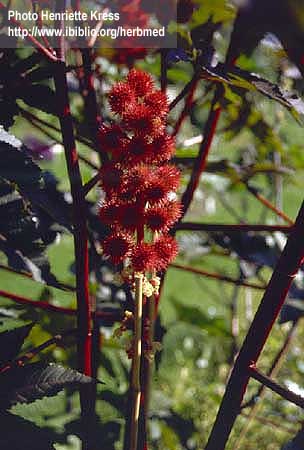Crops
Ricinus communis L. - Castor
Taxonomic position.
Family Euphorbiaceae Juss., genus Ricinus L.Biology and morphology.
This is a biennial plant that grows up to 10 m tall. In countries with temperate climates, it is cultivated as an annual plant. In its first year, it grows to 60-500 cm tall and perishes during autumn frosts. The root system consists of a well-developed taproot that reaches depth of 3-4 m. Stalk is hollow and branched. Leaves are large, 25-40 cm long, peltate, seven- or nine-bladed, glaberous, lustrous, on a long (25-60 cm) leaf stalk. Plant is green or red-violet, often with a thin, waxy coating. Inflorescences are racemes 60-80 cm long, located on the ends of branches. Male flowers occupy lower part of the raceme; female flowers occupy the upper part; all are apetalous. Fruits are spherical or oblong pods, 2-3 cm across, usually with prickles, three-celled, with 1 seed in each cell. Seeds are 8-20 mm across, oval, lustrous, with or without papilla-shaped excrescence (caruncle), gray to dark red with gray or other color mosaic. Plants are either cross- or self-pollinated; usually anemophilous. 2n=20Ecology.
Thermophilic plant, suffers from frosts. Shoots perish at temperatures below -1°C; adult plants die at temperatures below -3 to -4°C. Temperatures should not fall below 20-25°C to ensure normal plant development. It withstands some drought, although at least 300 mm of precipitation during the vegetative period is needed for growth. With moisture deficits, seed yield is sharply reduced. Requires fertile soil; produces high yield on fertile, well-aerated soils with a pH of 6-7.3. It is a short-day species, photophilous. Vegetative period (from shoot emergence to maturing of first raceme) lasts 100-150 days.Distribution.
This species originated in East Africa, where solid thickets of castor grow. Cultivation of castor in Russia was first recorded in 1840. In former Soviet times, crops occupied 132 thousand hectares. The crop is cultivated in the southern Ukraine (Zaporozhye, Kherson, and Dnepropetrovsk areas), in the Krasnodar and Stavropol territories, in the Rostov area, and in the Northern Caucasus. The crop is also grown on a smaller scale in the republics of Central Asia and in the Lower Volga region. Popular varieties include: VNIIMK 165, Hybrid ranny, Donskaja 39/44, Kruglik 5, Stepnaja 6, Krasnodarsky 3, Kubanskaja 15, and Chervonnaja.Utilization and economic value.
Seeds contain 40-58% non-drying oil, which has a special viscosity that does not harden at low temperatures. Oil is used to grease aviation motors, as well as in metallurgy, tanning, textiles, and soap-producing industries. It is also used to manufacture nylon fiber, linoleum, and various synthetic products. Oil is inedible and used as a laxative in medicine (castor oil). Oil cake is applied as a fertilizer. Fibers of stalks are used to make ropes and sacks. It is also raised as an ornamental plant. In crop rotation, it is usually placed after winter crops, such as sugar beet and corn. It is cultivated as a row crop. The crop is sown when soil temperatures are greater then 12-14?C. For wide-row crops, 25 to 30 kg seeds per hectare are sown; seeds are planted 8-10 cm deep. Ripens non-uniformly. Varieties with dehiscing fruits are gathered two to three times during the process of maturing; varieties with non-dehiscing fruits are processed with defoliants and harvested by combine. Productivity is 0.5-2 tons per hectare.Reference citations:
Korenev G.V. 1990. Plant Growing with Basics of Selection and Seed Growing. Moscow: Agropromizdat. 574 p.Niklyaev V.S., ed. 1990. Basics of Agriculture and Plant Growing. Moscow: Agropromizdat. 478 p.
Vekhov V.N., Gubanov I.A., Lebedeva G.F. 1978. Cultural Plants of the USSR. Moscow: Mysl.. 336 p.
Zhukovskii P.M. 1971. Cultural Plants and their Relatives. Leningrad: Kolos. 751 p. (In Russian)


